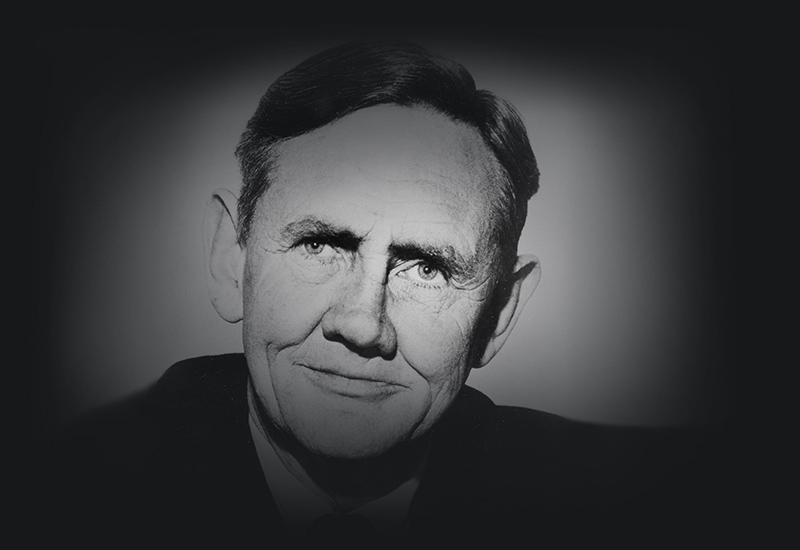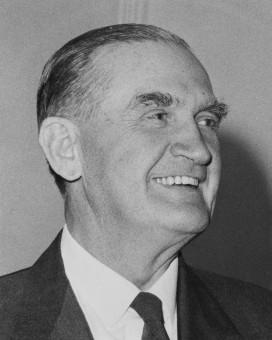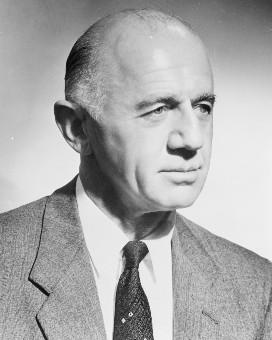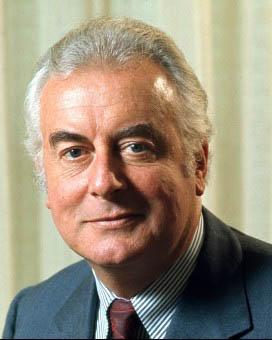John Gorton was the only Prime Minister to come from the Senate. In this outline of the 10 elections Gorton contested, 5 are Senate elections where he was on the Victorian ticket (1949–64). 4 are elections for the House of Representatives seat of Higgins (1968–75). The last is the 1975 election when Gorton stood unsuccessfully for an Australian Capital Territory Senate seat, campaigning as an Independent after his resignation from the Liberal Party.
10 December 1949
In 1949, the House of Representatives was enlarged from 74 to 121 members and the Senate from 36 to 60 members. In this election, the Liberal–Country Party Coalition defeated the Chifley Labor government, winning 50.3% of the valid votes and taking 74 seats in the House of Representatives, to Labor’s 47 seats. Robert Menzies became Prime Minister for the second time.
Under the newly introduced system of proportional representation for Senate seats (replacing the preferential system), the Coalition won 23 of the 42 seats, remaining in the minority. The Coalition won 50.4% of the Victorian Senate vote and Gorton and Ivy Wedgwood both became senators.
28 April 1951
After the Labor-dominated Senate refused to pass the government’s banking legislation, Menzies obtained a double dissolution. His government was returned to office with 50.34% of the valid votes and 69 seats in the House of Representatives to Labor’s 54 seats. The Coalition won control of the Senate with a 32–28 seat majority. Labor won a majority of the Senate votes in Victoria (50.1%), but the Coalition and Labor each took 5 seats and Gorton was returned for Victoria.
9 May 1953
Because he was one of the last 5 senators elected in 1951, Gorton’s term expired on 30 June 1953 and he had to face the polls again. He headed the joint Liberal Country Party – Country Party ticket for Victoria and was elected.
The Coalition vote, however, fell to 44.5%, and Labor won 3 of the 5 seats. This election marked a low point for the Menzies government, although it managed to retain a 31–29 majority in the Senate. It narrowly maintained power with a 5-seat majority in the elections for the House of Representatives on 29 May 1954, even though Labor won 50.03% of the valid vote.
22 November 1958
The Labor Party split of 1954–55, and the formation of an Anti-Communist Labor Party (later, the Democratic Labor Party), prompted the Menzies government to go early to the polls, on 10 December 1955. Helped by Anti-Communist Labor preferences, it increased its majority in the House of Representatives (now 122 members) from 5 to 28. It lost control of the Senate, with the balance of power held by 2 Anti-Communist Labor senators, Tasmania’s George Cole and Victoria’s Frank McManus.
The government increased its majority in the House of Representatives in 1958 from 28 to 32, assisted by Democratic Labor Party preferences. It also regained control of the Senate. In Victoria, where there were 6 vacancies, Gorton headed the Senate ticket and was the first candidate to reach a quota. The Coalition and Labor each took 3 seats.
5 December 1964
Following the 1960 credit squeeze and an economic downturn, the Menzies government barely survived the House of Representatives election of 1961. It now had a 62–60 majority, although it did retain control of the Senate. Menzies had seized the opportunity of improved political circumstances to hold an early election on 30 November 1963 and a big swing to the Coalition in New South Wales enabled him to increase his majority in the House of Representatives to 22.
In the separate, half-Senate election in 1964, Gorton again headed the joint Liberal and Country Party ticket in Victoria and was the first candidate to reach a quota. The Coalition and Labor each won 2 seats and the Democratic Labor Party took one. The government once again lost control of the Senate, with the Democratic Labor Party senators, Queensland’s Vince Gair and Victoria’s Frank McManus, and a Tasmanian Independent, Reg Turnbull, holding the balance of power.
24 February 1968
This by-election for Harold Holt's safe Liberal seat of Higgins was the means by which Gorton entered the House of Representatives. The head of government is drawn from the House of Representatives and, although elected leader of his party, as a senator, Gorton could not be the Prime Minister. In the by-election, Labor opposed him and the Democratic Labor Party did not nominate a candidate. Gorton obtained 69.4% of the vote, beating Holt’s previous best return for the seat in 1955 by 5%.
The Coalition had won what was then a record majority of 39 for the House of Representatives on 26 November 1966, in an election fought largely over the issues of conscription and Australia’s involvement in the Vietnam war. The Coalition vote fell sharply, however, in the Senate election of 25 November 1967, and the Democratic Labor Party managed to win 2 more Senate seats.
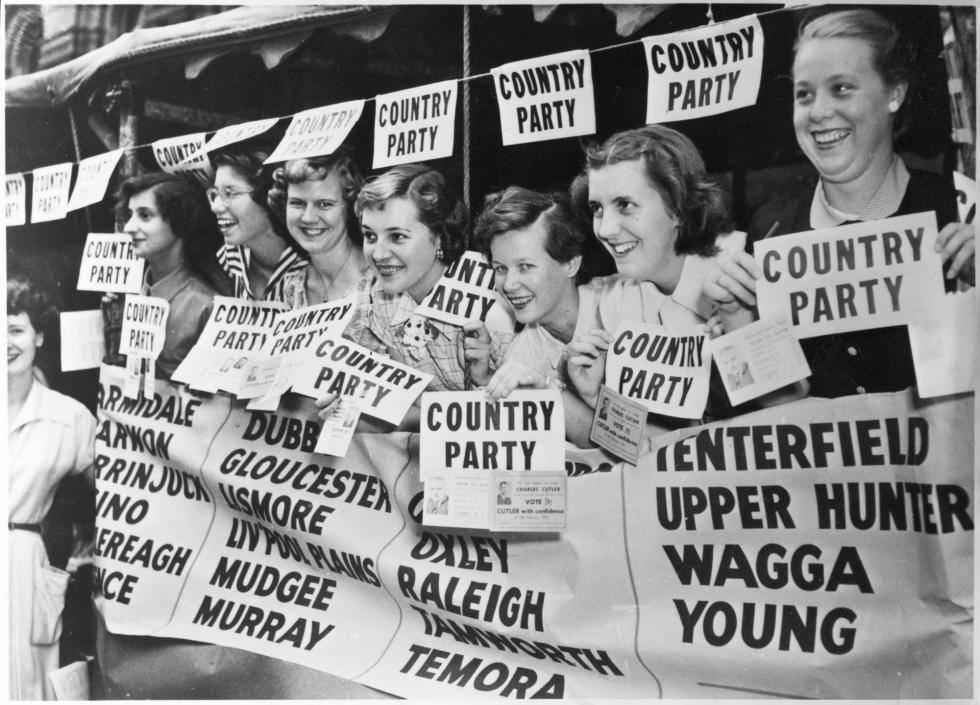
A Country Party NSW election stall, 1968. NAA: A1200, L69306
25 October 1969
Gorton’s first election as Prime Minister resulted in a swing against the Coalition government of nearly 7% and its majority fell from 39 to just 7. His government survived on the basis of Democratic Labor Party preferences in 4 seats. Gorton’s own vote in Higgins fell from 69.4% to 58.5% (though this was still higher than the 56.7% Harold Holt received in the 1961 election).
Many Liberals blamed Gorton for the severe reversal, pointing out that the anti-government swing occurred at a time when the economy was booming and when most Australians were enjoying an improved standard of living. They criticised Gorton for what they saw as his divisive stand over Commonwealth–state financial relations, his tendency to make policy on the run and his free-wheeling campaign style. Gorton was at first reluctant to take any personal responsibility, preferring to explain the result in terms of traditional Labor voters returning to the fold, the effects of an electoral redistribution and the appeal of Labor’s welfare promises. The Democratic Labor Party saw Gorton as ‘soft’ on Communism, and this also cost electoral support.
His government also polled poorly in the half-Senate election on 21 November 1970. The Coalition’s 38.2% share of the vote was the second worst result for non-Labor since Federation (the worst being the 1943 election). The one consolation was that Labor’s share of the primary vote was just 42.2%. The Democratic Labor Party was the real winner, picking up a seat in New South Wales for a total of 5 in the Senate.
Although the Liberal Party was inclined to blame the press for its campaign against the Prime Minister, it was clear that internal hostility to Gorton’s leadership was undermining party unity.
2 December 1972
Labor won government and Gough Whitlam became Prime Minister. Gorton held Higgins with 53.4% of the vote, though his primary vote had taken a further fall of 5.1% since 1969.
William McMahon, who had replaced Gorton as Prime Minister on 10 March 1971, led the Coalition to a narrow defeat – Labor’s majority in the new House of Representatives was just 9 seats.
18 May 1974
Faced with Senate obstructionism, Whitlam sought and obtained a double dissolution. Labor was returned to power with 66 seats to 40 Liberal and 21 Country Party seats. The Senate was evenly balanced with 29 Labor and 29 coalition seats. Gorton held Higgins, his primary vote of 58.6% just exceeding his 1969 level.
13 December 1975
At this double dissolution election after Governor-General Sir John Kerr dismissed the Whitlam government, John Gorton was again standing for the Senate, but for 1 of the 2 new Australian Capital Territory (ACT) Senate seats. He was standing as an Independent, as he had left the Liberal Party on 23 May 1975. Gorton opposed the Coalition’s decision to use the Senate to withhold Supply to the Whitlam government and in this election publicly advocated a vote for Labor in the House of Representatives.
The Coalition swept to power in the election, taking control of both Houses. Gorton managed to secure 11% of the primary vote in his quest for an ACT Senate seat, but the 2 major parties took 80% between them and each won a seat.
Sources
These brief election results relate only to this Prime Minister. They are drawn from the online sources below, where further information can be found.
Australian Electoral Commission: Election results
University of Western Australia: Australian Government and Politics Database

